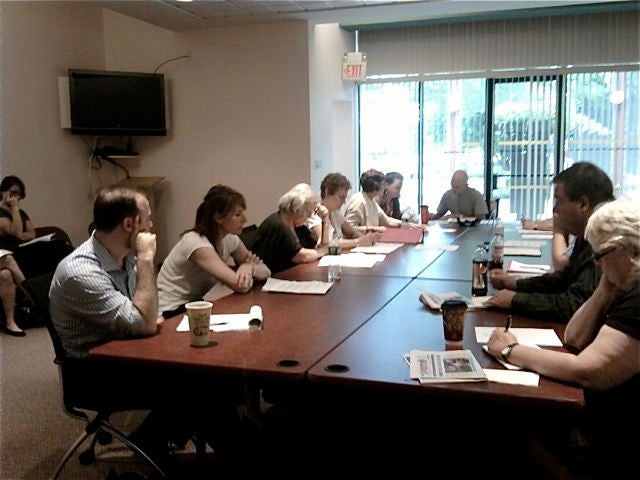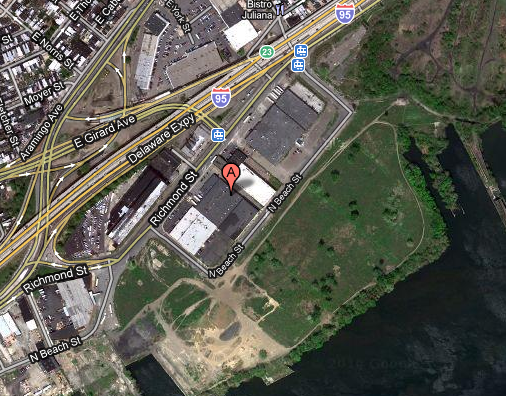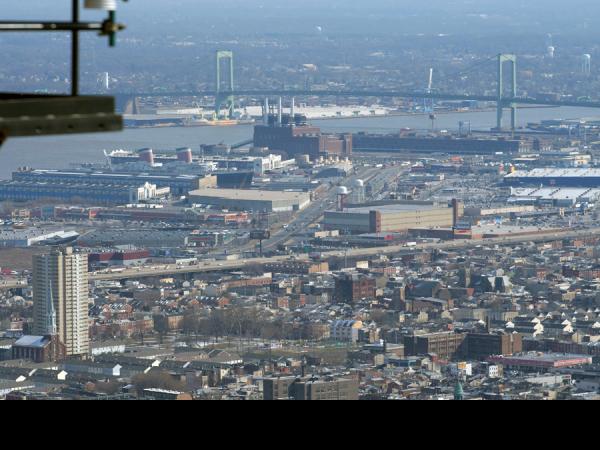Monday’s master plan unveiling to include before-and-after renderings of the Central Delaware
Eleven before-and-after renderings of key sites along the seven-mile stretch of the Delaware River Waterfront will be shown to the public as part of the Monday release of the draft summary of the Central Delaware Waterfront Master Plan.
Master Plan Manager Sarah Thorp told the Central Delaware Advocacy Group at its Thursday meeting that much of the event at the Festival Pier will focus on these new drawings and the illustrated, 50-page draft document. There will also be presentations from the consulting team that worked on this blueprint for the future of the riverfront, and a short panel discussion with an audience Q and A.
CDAG, which is comprised of representatives from waterfront civic groups and other organizations, exists to lobby for the public’s waterfront desires and goals. Thorp works for the quasi-city agency that oversees the city’s waterfront land and the master planning process for the entire 7-mile stretch between Oregon and Allegheny avenues, the Delaware River Waterfront Corporation. She thanked CDAG for a letter it sent to DRWC this month, listing its comments on the latest version of the plan that they have seen, and said she plans to incorporate some of them into the presentation.
This includes addressing what CDAG called the “appearance of inequity in investment in the far-north and far-south areas” of the Central Delaware.
“Despite the Consultants’ good work fleshing out plans for the far north and far south portions of the Central Delaware, the perception of inequity remains among many stakeholders in those areas. This is primarily because the difference between what is planned for those areas, and when the plans can be implemented, has not been made sufficiently clear,” the document reads.
The timeline on these areas is significantly longer than in the central part of the plan, where much more land is in the city’s hands.
Thorp said this topic would be addressed Monday, but she added that the concerns in the north and the south are quite the same. The north contains large swaths of land that are not in use or underutilized. But in the south, a lot of the land is dedicated to the working port – and that is something that residents there want to protect. They do not want to see a lot of changes there, she said.
Pennsport’s CDAG representative,Tom Otto, backed Thorp up on this. But there are parcels of land southern-end residents hope will be developed under the plan, he said. For example, Otto said, It would be wonderful if there’s no Foxwoods Casino, and that parcel can be turned into something the community would welcome.
CDAG Chairman Steven Weixler and Old City representative Joe Schiavo said they hoped the master plan team could talk about transportation options for the Central Delaware. The master plan talks about a light-rail line for the waterfront, but CDAG noted in its letter that funds “might not be available for years.”
“CDAG suggests a more fleshed out, phased approach, including hybrid buses or electric, trackless trolleys, deployed in trials to test routes, build ridership, and test connections to existing hubs like 2nd and Market, 2nd and Spring Garden, Market East, Suburban Station, and 30th St. Station,” the letter states.
Thorp said there would not be much time devoted to transportation during Monday’s session – time is just too limited. But Thorp said that while DRWC is committed to pushing for light rail along the waterfront, there are interim solutions in the works. There are already shuttle buses for some destinations, and this could be expanded, she said. DRWC is talking to SEPTA about a new bus line for the waterfront, Thorp said, and trackless trolleys – vehicles that look like trolleys but ride on wheels like a bus – are another possibility.
Some of CDAG’s suggestions, such as requiring “step backs” adjacent to trails and access points to avoid “a claustrophobic or ‘cavern’ effect when large buildings abut the waterfront trail, setback, and cross streets,” need to be dealt with via zoning, not in the master plan, Thorp said.
Thorp said the full draft, which will be about 250 pages, will be released within a month or so of the 50-page summary’s release. Public comment will be taken through mid-August, she said, and it will be up to the staff at the quasi-city agency where she works, the Delaware River Waterfront Corporation, to incorporate it into the document, since the consultant’s work will be done. A “release party” will be held to celebrate the release of the final document in mid-September, she said.
“Also in September, we will announce two years’ worth of new projects,” Thorp said.
While staff can and will change text to reflect public input, it’s likely that the illustrations cannot be changed, Thorp said.
Sandy Salzman of New Kensington CDC asked if an illustration the public found “totally offensive” could be removed from the plan altogether, and Thorp said it could.
Otto resurrected an issue that has existed ever since Mayor Michael Nutter imploded the Penn’s Landing Corporation, and created the DRWC to replace it. “We need live representation on DRWC,” he said.
Thorp said she and her boss, DRWC President Tom Corcoran, are aware that CDAG would like to have a representative on the board, but said it isn’t up to them – it’s Nutter who appoints board members.
“Then we’ve got to get to the mayor and other politicians,” Otto said.
“We deserve at least two seats,” Weixler said.
Monday’s release of the draft summary will take place at the Pavilion at Festival Pier from 6:30 to 8:30 pm.
Video to come.
Reach the reporter at kgates@planphilly.com.
WHYY is your source for fact-based, in-depth journalism and information. As a nonprofit organization, we rely on financial support from readers like you. Please give today.






